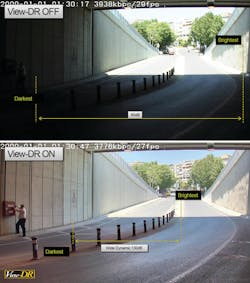Wide dynamic range (WDR) is one of the most popular features in IP cameras today. According to the research group IHS Inc., approximately 22 percent of IP cameras shipped in 2012 had WDR capabilities, which IHS defines as a dynamic range greater than 60 decibels (dB).
There is no argument that WDR is an important technology, as it allows clear images to be seen in light and dark areas simultaneously — rather than overexposing or underexposing various areas of the scene. However, the security industry lacks standards around WDR, which means that not all IP cameras claiming to have the technology are created equal.
As any security dealer or integrator knows, WDR-enabled IP cameras from various manufacturers have vast differences in performance when they are actually installed. There are many instances where one vendor’s non-WDR camera outperforms an IP camera from a different vendor claiming to have the technology. Therefore, WDR-enabled cameras have to be field tested to get a real sense of performance because nobody can accurately compare performance based on product specification sheets alone.
Given this wide range of performance, every security professional needs to ask manufacturers three important questions when selecting IP cameras with WDR capabilities:
1. What is the camera’s specific decibel level?
Knowing the exact decibel level of the camera is critical because decibels represent the ratio of digitized light levels that image sensors can detect. The higher the number, the better the video will be despite high-contrast scenes.
Assuming we use the IHS criteria as the minimum, WDR can vary from a low of 60dB to a high of 130dB in the best-performing IP cameras on the market. With as many as 70dB separating wide dynamic IP cameras and no standard defined by the security industry, it is no wonder that performance varies so dramatically and security professionals have a difficult time determining which WDR camera will work best. This is also why some non-WDR cameras perform better in the field than WDR-enabled cameras. Each manufacturer sets its own criteria for what constitutes WDR. For example, one might call a camera with a 60dB rating WDR, while another will not label its products as WDR unless they have at least a 90dB rating.
Manufacturers should list their cameras’ decibel levels on product specification sheets, but many choose not to make this information public. At the very least, they should provide the information if asked a direct question. If a manufacturer will not provide the specific decibel level of a camera, it is very likely that the rating is low and the camera and will not work well in high-contrast environments.
2. How fast can the camera adjust to sudden, high-contrast changes in lighting conditions?
Even if a camera’s decibel rating is good, some can take up to 15 seconds to adjust to a sudden and drastic lighting change, such as headlights shining directly into a dark window. In the security industry, 15 seconds can make a tangible difference in the performance and success of critical surveillance applications. Looking at transportation or city surveillance applications for example, 15 seconds could make the difference between catching someone as he drops off a suspicious package or letting him get away.
The WDR functionality on an IP camera should be able to adjust to sudden changes in lighting within two to four frames. This is less than one second depending on video streaming speeds. Otherwise, users risk missing crucial video that could ultimately compromise safety.
3. Can the camera automatically turn off its WDR configuration when it is not needed?
Security cameras are often located in areas that experience extreme differences in lighting conditions on a daily basis. For example, a loading dock might experience bright morning sun, which then dissipates in the afternoon hours and creates a more evenly lit scene. Likewise, a cloudy day could mean that WDR capabilities are not required even though they are needed on sunny days.
However, many IP cameras on the market today cannot be configured to detect differences in lighting and automatically turn off their wide dynamic range settings when they are no longer needed. The WDR functionality is either “off” or “on,” and it is up to a security professional to manually change the setting.
This is problematic because keeping the wide dynamic range settings on when they are not required results in grainy video. Depending on the severity, the video could be useless. Even if it is still usable, grainy video increases bandwidth usage and storage requirements because the “movement” of pixels in the field of view causes the frame size to increase. The pixel movement can also cause problems if the user is running video analytics. Grainy video can trigger false alarms because the software picks up changes in the pixels and processes them as a possible security threats.
There have been many tutorials written by reputable companies about WDR technology. They typically focus on how the technology works, why it is important, and when it should be used; however, the ones we have seen to date have not addressed the critical questions regarding decibel ratings, adjustment speeds and automatic detection, which play an important role in how well WDR-enabled IP cameras perform. Getting the answers to these questions will help security dealers and integrators make more informed decisions in the future and enable them to intelligently explain why WDR cameras deliver wildly different results, even though they all claim to have the same technology.
Kenichi Mori is Director of Marketing & Product Management for Sony Electronics’ Professional Solutions Group. Request more information about Sony by visiting www.securityinfowatch.com/10215743.
About the Author
Kenichi Mori
Kenichi Mori is Director of Marketing & Product Management for Sony Electronics’ Professional Solutions Group. Request more information about Sony at www.securityinfowatch.com/10215743.
